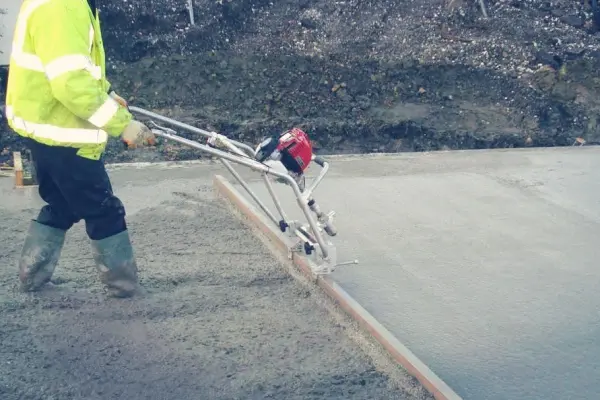The modern process of concrete placement requires the use of special equipment to achieve optimal results. What is a vibrating screed? It is an indispensable tool in construction that allows for quick and efficient leveling and compaction of concrete surfaces. According to the Global Construction Equipment Market Research report for 2025, using a concrete vibrating screed increases the strength of the covering by 20-30% compared to manual leveling. In January 2025, a basic model of a screed vibrating compactor costs approximately $550, and the vibrating screed market is valued at $480 million and, according to industry forecasts, will grow to $650 million by 2028. But how does a vibrating screed work and what types exist? Let's find out.
What is a vibrating screed and what is it used for
A vibrating screed is specialized construction equipment designed to compact and level concrete mix after pouring. It consists of a profile with an attached vibration mechanism. This tool transforms concrete. Honestly, working with concrete without this tool turns into a real puzzle, especially in large areas where manual leveling takes too much time and doesn't give such a quality result.
The main purpose of a vibrating screed is to remove air from the concrete mix and distribute it evenly across the surface. As a result – a more durable and strong concrete covering. It's no secret that air voids significantly reduce the strength of concrete. A vibrating screed solves this problem like a magic wand for concrete, turning a porous mass into a monolithic structure.
"The use of vibrating screeds in modern construction has become a quality standard. Our research shows that the proper application of this tool increases the lifespan of concrete coverings by an average of 7-10 years," – notes the American Concrete Institute (ACI) in its report on concrete compaction technologies for 2024.
The principle of operation of a vibrating screed: how this device levels concrete
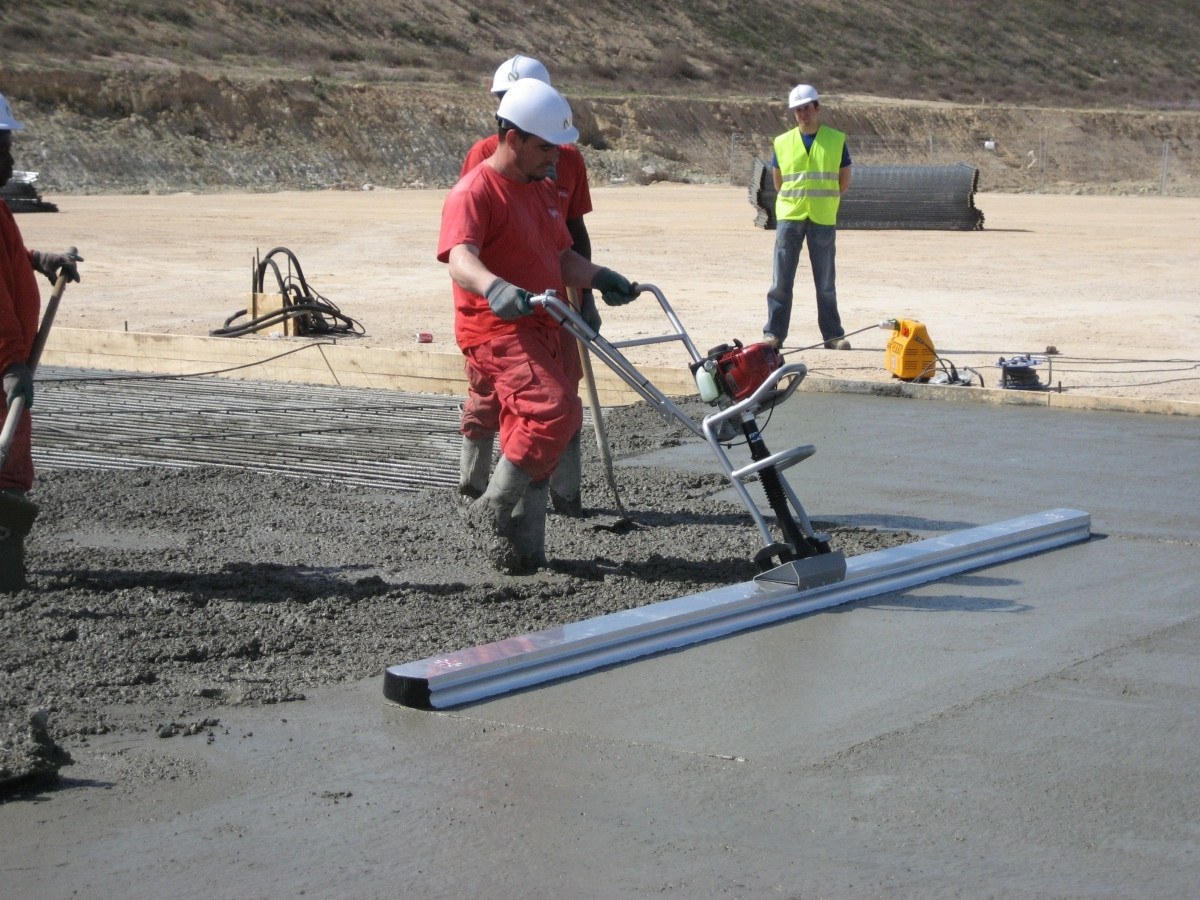 The principle of operation of a vibrating screed is based on vibrational impact on the concrete mix. Last season I observed the work of a construction crew and was impressed by the efficiency of this simple but ingenious device. Vibration works wonders. The vibrating screed's engine creates torque, which is converted into oscillations with a frequency of up to 9000 per minute, causing the particles of the concrete mix to move and rearrange into a denser structure.
The principle of operation of a vibrating screed is based on vibrational impact on the concrete mix. Last season I observed the work of a construction crew and was impressed by the efficiency of this simple but ingenious device. Vibration works wonders. The vibrating screed's engine creates torque, which is converted into oscillations with a frequency of up to 9000 per minute, causing the particles of the concrete mix to move and rearrange into a denser structure.
During operation, the following occurs:
- Vibration is transmitted to the concrete mix, making it more mobile.
- Under the influence of vibration, air bubbles rise to the surface and exit the mix.
- Excess water is displaced, which increases the density and strength of the concrete.
- The concrete mix is evenly distributed, forming a level surface.
- Concrete compaction occurs, improving its structural properties.
This process resembles the operation of a washing machine with concrete – vibration causes the particles to "pack" more densely, eliminating all excess. The result is a homogeneous concrete covering of excellent quality.
Comparison of vibrating screed with other methods of concrete compaction
A vibrating screed is not the only method of concrete compaction. I often encounter the question: "How is a vibrating screed better than other tools?" Let's compare the main methods of working with concrete mix and understand when which tool is more effective.
- Immersion vibrator – immersed directly into the concrete mix and is effective for massive structures (foundations, columns), but less convenient for horizontal surfaces.
- Vibratory plate – good for large open areas, but does not provide the same evenness as a vibrating screed.
- Manual tamping – an economical solution for small volumes, but labor-intensive and does not provide uniform compaction.
- Screed vibrating compactor (vibrating screed) – optimal for horizontal surfaces, provides simultaneous leveling and compaction.
For the best results with large volumes of work, professionals often combine methods: first an immersion vibrator for compacting the mass of concrete, then a vibrating screed for leveling the surface. These tools complement each other like a good team of specialists.
Design and construction of a vibrating screed
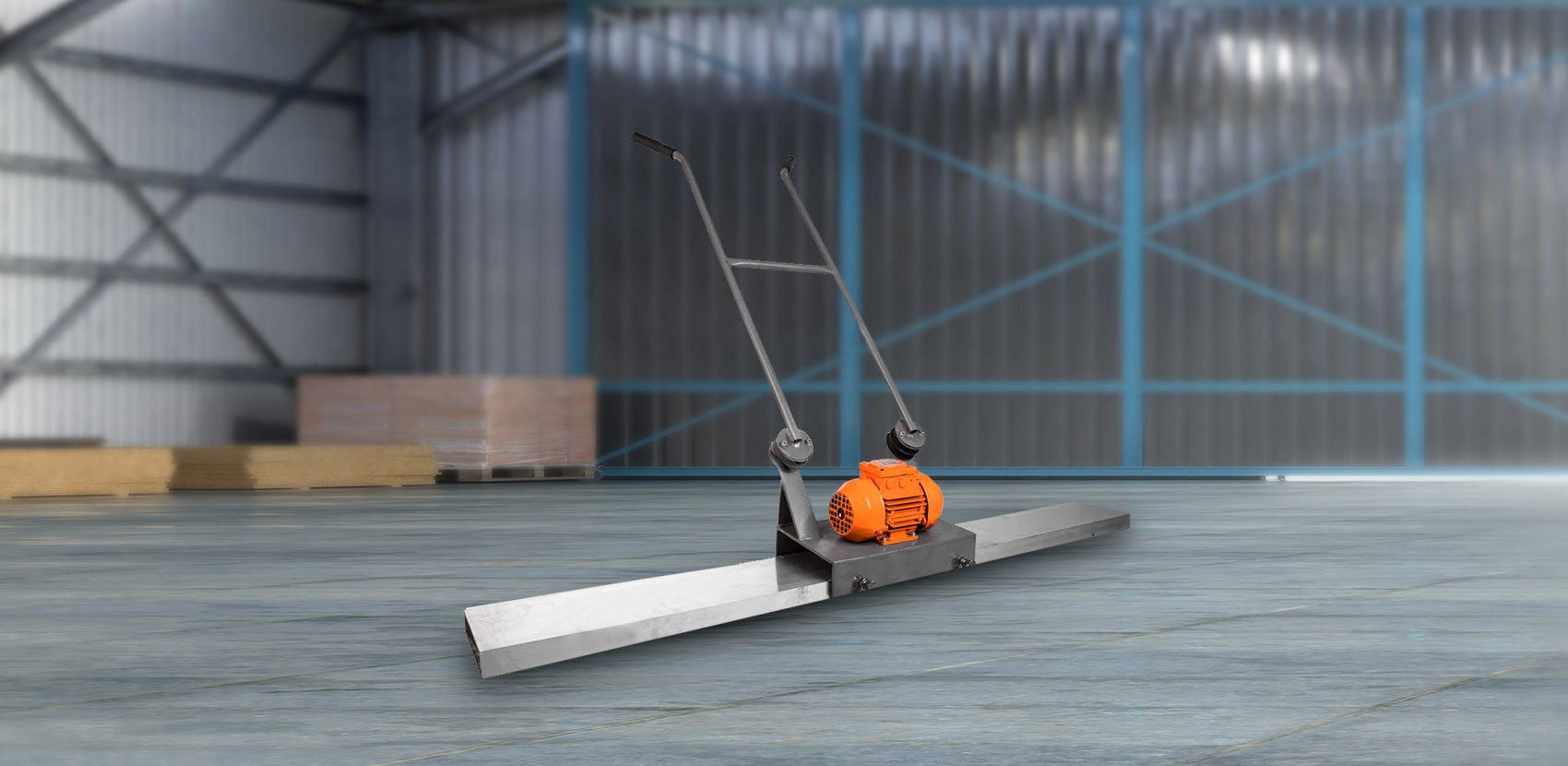 The design of a vibrating screed is relatively simple, while providing high efficiency. Like a piano, where simple mechanisms create amazing results, the construction of a vibrating screed includes several main elements:
The design of a vibrating screed is relatively simple, while providing high efficiency. Like a piano, where simple mechanisms create amazing results, the construction of a vibrating screed includes several main elements:
- Profile (screed) – usually aluminum or steel, length from 1 to 10 meters
- Vibration mechanism (vibrator) – creates the necessary oscillations
- Engine – gasoline or electric
- Control handles – for manipulating the tool
- Damping elements – to reduce vibration transmitted to the operator's hands
By the way, modern models of vibrating screeds are often equipped with additional elements, such as vibration frequency regulators, level control systems, and even laser pointers to increase work accuracy. Aluminum vibrating screed is now considered the most popular due to the optimal combination of weight and strength, although steel vibrating screed is still in demand for particularly intensive work.
| Type of vibrating screed | Power source | Compaction depth | Profile length | Application | Approximate cost |
|---|---|---|---|---|---|
| Floating | Electric/Gasoline | 15-18 cm | 1-5 m | Small areas, finishing | $600-1500 |
| On guides | Gasoline/Electric | up to 30 cm | 2-8 m | Large areas, roads, bridges | $1200-3000 |
| Vibrating float | Electric | 5-10 cm | 0.8-2 m | Finishing, fine-tuning | $400-800 |
| Telescopic | Gasoline | 20-25 cm | 2-4.5 m (extensible) | Universal application | $1500-2500 |
| Sectional | Gasoline | up to 30 cm | up to 30 m | Industrial facilities, airfields | $3000-10000 |
The choice of vibrating screed type depends on the specific construction conditions and requirements for the quality of the concrete surface. This table will help determine the optimal option for your tasks, considering both budget and project specifics.
Types of vibrating screeds: which to choose for different tasks
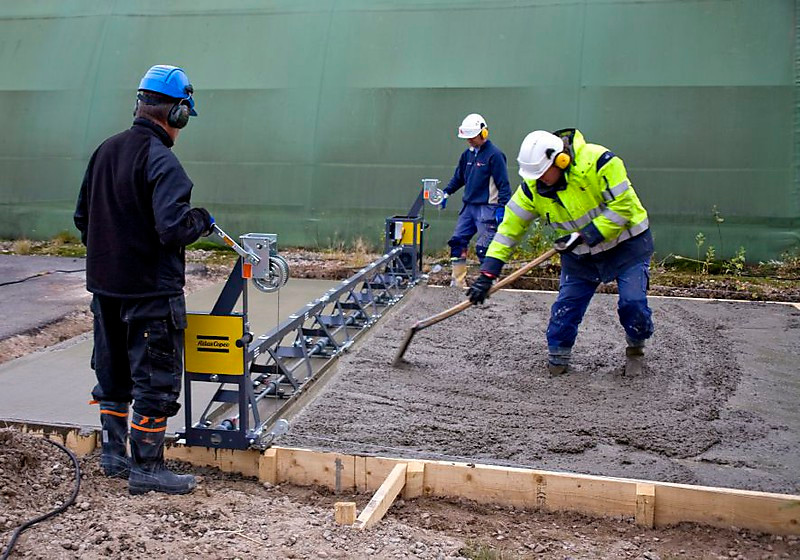 Types of vibrating screeds are diverse and can be classified by several characteristics. In a construction store in Kyiv, I noticed that even sales consultants cannot always explain the difference between all types. They get confused. Let's look at the main varieties of this indispensable tool so you can make the right choice depending on your needs.
Types of vibrating screeds are diverse and can be classified by several characteristics. In a construction store in Kyiv, I noticed that even sales consultants cannot always explain the difference between all types. They get confused. Let's look at the main varieties of this indispensable tool so you can make the right choice depending on your needs.
By method of movement
Floating vibrating screed – the most common type. Installed directly on the concrete surface and moves across it, compacting and leveling the mix. One of the main advantages – ease of use, even one operator can handle it.
Vibrating screed on guides – moves along pre-installed guide rails, which ensures high accuracy of leveling. In my experience, this is the best solution for objects requiring perfect surface evenness, such as industrial floors, where flatness tolerances are measured in millimeters, and the total area can reach several thousand square meters.
"In 2021, during the construction of a logistics center with an area of 5000 m², we faced the need to create a perfectly flat floor with a tolerance of no more than 2 mm over 2 meters. Standard methods did not provide the necessary accuracy. The solution came with the use of a laser-guided vibrating screed. Work that was planned to take two weeks was completed in 6 days, and the quality exceeded all expectations. A big advantage was the ability to work simultaneously on a large area with a minimum number of personnel. After this project, we switched to using vibrating screeds in all our construction projects, which allowed us to reduce work time by an average of 40% and significantly improve the quality of concrete coverings."
By engine type
Gasoline vibrating screed – characterized by high power and autonomy, ideal for working in open areas without access to electricity. Works on regular gasoline, which provides mobility and independence from external power.
Electric vibrating screed – more environmentally friendly, does not emit exhaust gases, which makes it a preferred option for working in enclosed spaces. Requires connection to the electrical grid, but usually more economical to operate.
By design
Double vibrating screed – has two parallel profiles, which provides greater stability and prevents bending. This design is especially effective when working with large areas.
Telescopic vibrating screed – equipped with an extensible profile, the length of which can be adjusted depending on the width of the surface being processed. A universal solution for various tasks.
Vibrating float – a lightweight version of a vibrating screed, designed for finishing the concrete surface. Not always suitable for primary compaction. But effective.
Safety measures and environmental aspects of using vibrating screeds
When working with a vibrating screed, it is necessary to observe certain safety measures to avoid injuries and minimize negative impact on the environment. Protection is important. From my own experience, I can say that neglecting these rules can lead to serious consequences, ranging from vibration disease to injuries from unforeseen situations at the construction site.
Work safety:
- Always use protective gloves with anti-vibration effect to prevent vibration disease
- Wear a respirator when working with dry concrete mixes to avoid inhaling cement dust
- Use protective glasses to protect eyes from splashes
- Take breaks every 30-45 minutes of work to reduce the impact of vibration
- When working with electric models, avoid contact of the cable with water and use RCDs
Environmental aspects:
- Gasoline vibrating screeds emit exhaust gases, so do not use them in enclosed unventilated spaces
- Modern electric models from Husqvarna, Wacker Neuson, and ENAR have low noise levels (70-80 dB) and comply with EU environmental standards
- When choosing between types of vibrating screeds for work in residential areas, electric models are preferable
- Disposal of used oil and filters from gasoline vibrating screeds should be done at special points
Following these recommendations will not only ensure work safety but also reduce negative environmental impact, which is becoming an increasingly important aspect in modern construction, where environmental standards are constantly tightening.
Application of vibrating screed: where and when to use
The application of vibrating screed is quite diverse and covers many construction processes. You'll be surprised. From small private projects to large-scale industrial facilities – this tool finds its application everywhere where quality work with concrete is required.
Main areas of use:
- Construction of concrete floors in industrial buildings
- Creation of screeds in residential premises
- Construction of roads and sidewalks
- Development of platforms and parking lots
- Construction of various types of foundations
- Construction of bridges and other engineering structures
A vibrating screed for concrete placement is especially effective when working with large areas, where manual leveling would take too much time and effort. A vibrating screed for screed allows you to create a perfectly level surface for subsequent flooring installation.
A vibrating screed for concrete compaction is used in the initial stages of working with concrete mix, when it is necessary to remove air and excess water. And a vibrating screed for leveling concrete is used to create a smooth surface in the final stages. Wherever quality concrete covering is required, this tool will become an indispensable assistant in achieving professional results.
How to properly work with a vibrating screed: instructions for beginners
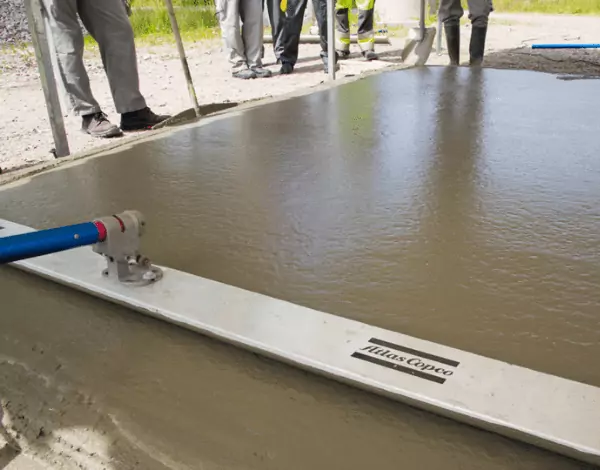 Working with a vibrating screed requires certain skills and adherence to technology. To get a quality result, follow these recommendations:
Working with a vibrating screed requires certain skills and adherence to technology. To get a quality result, follow these recommendations:
- Prepare the surface – remove large debris and set up screeding rails if necessary.
- Pour the concrete mix and preliminarily level it.
- Start the vibrating screed engine and let it warm up.
- Place the vibrating screed at the beginning of the work area.
- Slowly and evenly move the vibrating screed across the surface, avoiding jerks.
- Make sure the screed always remains in contact with the concrete.
- If necessary, make repeated passes until the desired result is achieved.
- After finishing work, clean the equipment from concrete residue.
When working with a floating vibrating screed, it is necessary to move it towards yourself, whereas a vibrating screed on guides moves along the installed rails. A manual vibrating screed requires some physical strength but provides flexibility in application, allowing you to process even hard-to-reach areas.
Vibrating screed and screeding rails — how to work
Working with screeding rails significantly increases the accuracy of leveling. The technology is simple. First, rails are installed at the desired height with a step equal to the length of the vibrating screed plus 20-30 cm. Then concrete is poured between the rails, and the vibrating screed moves, resting on these guides. This approach ensures a perfectly level surface with a precisely given level, which is especially important when creating floors with a slope for water drainage or when working with large areas.
Typical mistakes of beginners when working with a vibrating screed:
- Too fast movement, not allowing the concrete to be sufficiently compacted
- Lack of overlap between passes, leading to uneven compaction
- Working with already setting concrete, when the vibrating screed is no longer effective
- Excessive vibration in one place, causing stratification of the concrete mix
- Insufficient cleaning of equipment after work, leading to its damage
"The correct technique of working with a vibrating screed is as important as the choice of the tool itself. Too fast movement can leave air voids, and too slow can lead to excessive removal of water and cement milk. The golden mean is found experimentally for each specific composition of concrete," – comments the European Ready Mixed Concrete Organization (ERMCO) in its technical guide.
Practical example: garage floor screed
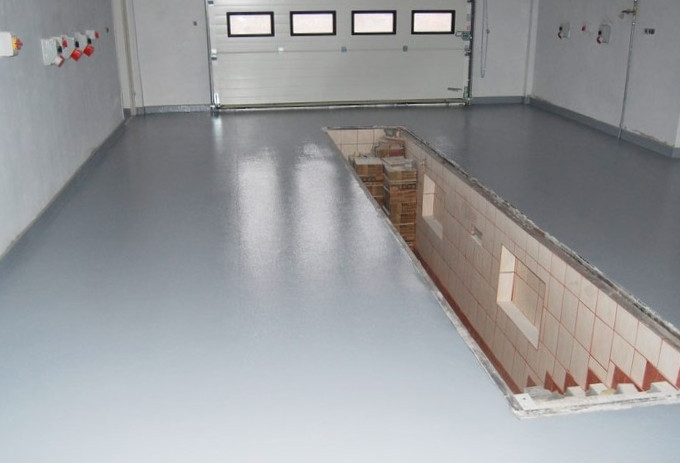 For a better understanding of the process of using a vibrating screed, let's consider a specific example – the construction of a floor screed in a garage with an area of 36 m² (6×6 m):
For a better understanding of the process of using a vibrating screed, let's consider a specific example – the construction of a floor screed in a garage with an area of 36 m² (6×6 m):
- Preparation: Cleaning the base, installation of screeding rails around the perimeter at the height of the planned screed (50 mm).
- Equipment selection: For such an area, an electric floating vibrating screed with a length of 2-3 meters is optimal.
- Preparation of the mix: M300 grade concrete with a plasticizer for better workability.
- Pouring: Even distribution of the mix across the entire area with a small height reserve.
- Working with the vibrating screed: Division of the area into strips about 1.5-2 m wide. Starting work from the far corner of the garage, moving the vibrating screed towards yourself at a speed of approximately 0.5-1 m per minute.
- Processing hard-to-reach places: Using a small vibrating float or manual straightedge for corners and places around communications.
- Finishing: After setting (2-4 hours), the surface is smoothed with a power trowel or manually for final leveling.
The result is a level surface with a deviation of no more than 2 mm over 2 m, which fully complies with building standards for garage premises. The entire process takes about 6-8 hours of work and requires 2-3 people (including preparation and delivery of concrete).
How to choose a vibrating screed: key characteristics and selection factors
The choice of a vibrating screed depends on many factors. This is important. When purchasing, pay attention to the following characteristics, which will help determine the model that is ideally suited for your specific tasks.
- Type of work – industrial areas require more powerful equipment than for home use.
- Area of the surface to be processed – the larger the area, the longer the screed should be.
- Thickness of the concrete layer – for thick layers, a more powerful vibrating screed is needed.
- Availability of electricity – in the absence of electricity, it's worth choosing a gasoline model.
- Working conditions – for enclosed spaces, electric models are preferable.
- Frequency of use – for regular work, it's worth purchasing professional equipment.
- Ergonomics – weight and ease of control are important for prolonged work.
- Vibrating screed power – working with stiff concrete mixes requires higher power.
The modern market offers a wide selection of vibrating screeds from leading manufacturers such as Wacker Neuson, Husqvarna, ENAR, and Masalta. Vibrating screed price varies from $400 to $10000 depending on the type, power, and additional functions. Buy a vibrating screed can be done directly from the manufacturer or through specialized online stores of construction equipment with delivery throughout the country. For small home projects, you can consider vibrating screed rental, which will significantly reduce costs.
| Type of work | Area | Recommended type of vibrating screed | Power source | Features |
|---|---|---|---|---|
| Home construction (floor screed) | up to 100 m² | Vibrating float, floating | Electric | Lightness, maneuverability, low noise level |
| Commercial premises | 100-500 m² | Floating, telescopic | Electric/Gasoline | Medium power, versatility |
| Industrial floor | 500-2000 m² | On guides, double | Gasoline | High accuracy, productivity |
| Road construction | more than 2000 m² | Sectional | Gasoline | Maximum productivity, durability |
| Fine finishing, decorative concrete | any | Vibrating float | Electric | Delicate impact, quality control |
This table will help determine the optimal type of vibrating screed depending on your specific needs and scale of work. For home projects, a cheap vibrating screed with basic functionality is often sufficient, whereas professional construction requires more serious investments in quality equipment.
Disadvantages of vibrating screeds and their limitations
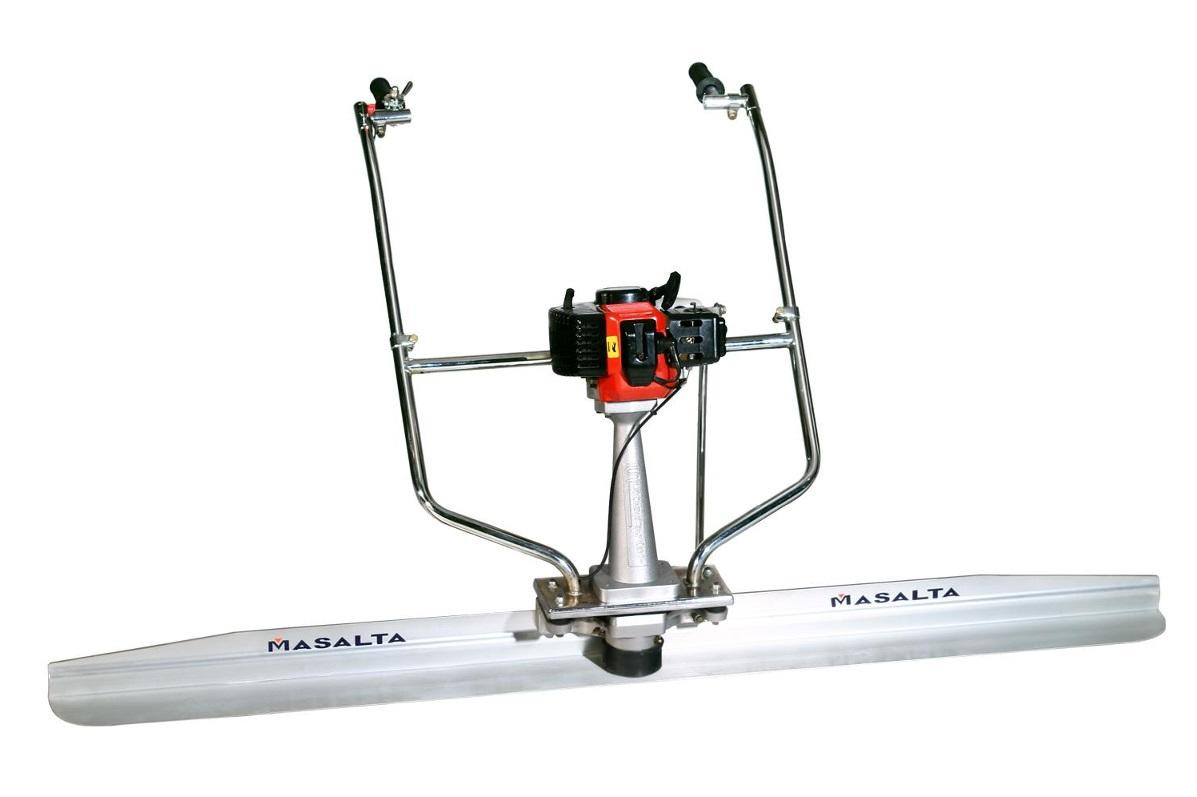 Despite all the advantages, vibrating screeds have certain limitations and disadvantages that should be known. Be realistic. Last year, when working on a residential complex project, I encountered some of these problems, which forced us to combine different compaction methods to achieve the optimal result.
Despite all the advantages, vibrating screeds have certain limitations and disadvantages that should be known. Be realistic. Last year, when working on a residential complex project, I encountered some of these problems, which forced us to combine different compaction methods to achieve the optimal result.
- Limited depth of impact - most models are effective only to a depth of 15-30 cm
- Noisiness - especially for gasoline models (85-95 dB), which can be a problem in residential areas
- Vibration load on the operator can cause fatigue and, with prolonged work, occupational diseases
- High cost of quality models, which may be an unjustified expense for one-time work
- Inefficiency for vertical surfaces and structures of complex shape
- Dependence on concrete composition - for too stiff mixes, additional equipment may be required
When choosing a vibrating screed, it is important to consider these limitations and, if necessary, supplement it with other tools for concrete compaction. In complex projects, a comprehensive approach is often required, combining different methods to achieve the best result.
Electric vs. gasoline vibrating screed: what is better to choose
One of the key questions when choosing a vibrating screed is the type of engine. Both gasoline vibrating screed and electric vibrating screed have their advantages and disadvantages. The choice is not simple. Let's consider them in more detail so you can make an informed decision based on specific conditions of use.
Advantages of a gasoline vibrating screed:
- High power and productivity
- Autonomy, independence from the electrical grid
- Mobility and ability to work in any conditions
- Suitable for large construction projects
- Usually more durable with intensive use
Disadvantages of a gasoline vibrating screed:
- High level of noise and vibration
- Emission of exhaust gases
- Requires regular maintenance (oil change, filters)
- Higher operating costs
- Greater weight compared to electric analogs
Advantages of an electric vibrating screed:
- Environmental friendliness, no exhaust gases
- Low noise level
- Simplicity in maintenance and operation
- Less weight, which simplifies the operator's work
- Economy in the long term
Disadvantages of an electric vibrating screed:
- Dependence on a source of electricity
- Limitation by the length of the electric cable
- Usually less power compared to gasoline models
- Risk of electric shock when working in wet conditions
- Not suitable for large-scale projects away from the electrical grid
When choosing the type of vibrating screed, consider the working conditions and environmental requirements. For work inside premises, electric models are preferable, and for open areas and autonomous work – gasoline ones. The lifespan of a vibrating screed directly depends on the correct choice of type for specific operating conditions and regular maintenance.
Innovative models of vibrating screeds in 2025
Technologies do not stand still, and modern vibrating screeds differ significantly from their predecessors. In 2025, innovative models with advanced functions are presented on the market, which automate concrete work and take quality to a new level.
- Wacker Neuson P 35A - equipped with a patented SureSpeed system, which automatically maintains the optimal engine speed regardless of load, providing uniform compaction quality.
- Husqvarna BV30 - laser level control system with an accuracy of up to 0.5 mm and a battery drive, providing up to 4 hours of autonomous operation.
- ENAR Tornado H - intelligent vibration amplitude adjustment system, adapting to different compositions of concrete mix for optimal compaction.
- Masalta MCB-H - combines a gasoline engine with an electric starter and a system to reduce vibration by 40%, which significantly increases operator comfort.
These models represent a new generation of construction equipment, where the emphasis is not only on efficiency but also on environmental friendliness and ergonomics. According to manufacturers, innovative vibrating screeds allow reducing work time by up to 30% and improving compaction quality by 15-20% compared to traditional models.
Vibrating screed for concrete buy which you can in a specialized online store or directly from the manufacturer, is now available with the possibility of delivery to any region. Modern digital platforms offer vibrating screeds with delivery within 1-3 days, which allows you to promptly start work.
Care and maintenance of a vibrating screed: how to extend the service life
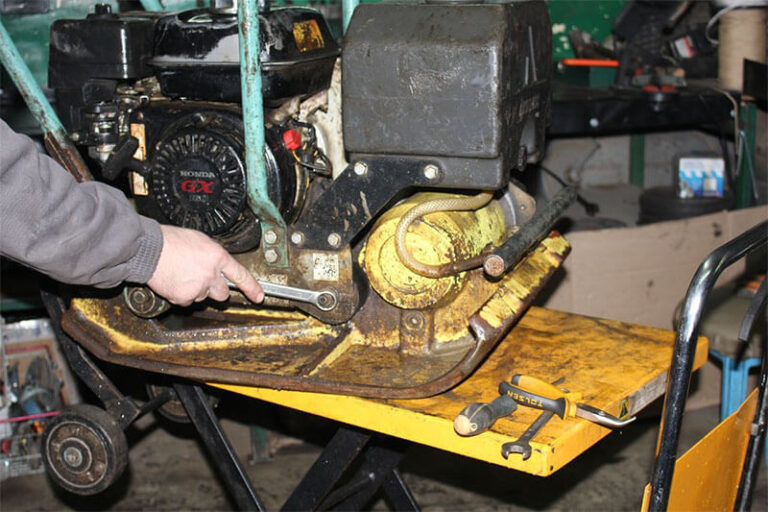 Proper maintenance of a vibrating screed significantly extends its service life and ensures trouble-free operation. This is often forgotten. In our construction company, we have established a clear maintenance schedule for all vibrating screeds, which has allowed us to increase their period of operation almost twice compared to the industry average.
Proper maintenance of a vibrating screed significantly extends its service life and ensures trouble-free operation. This is often forgotten. In our construction company, we have established a clear maintenance schedule for all vibrating screeds, which has allowed us to increase their period of operation almost twice compared to the industry average.
- Regularly clean the screed from concrete residue after each use
- Check and tighten all fasteners before starting work
- Monitor the oil level in the engine (for gasoline models)
- Periodically change air and fuel filters
- Check the condition of electrical cables (for electric models)
- Store equipment in a dry place, protected from dust and moisture
- Regularly lubricate moving parts and bearings
- Monitor the condition of rubber dampers and replace them in a timely manner
With intensive use, it is recommended to conduct technical maintenance every 100 hours of operation or once a month, whichever comes first. How to properly maintain a vibrating screed is a question that should concern every owner of this equipment, since not only the service life but also the quality of the work performed directly depends on it.
"Our experience shows that regular maintenance of a vibrating screed reduces the likelihood of breakdowns by 70% and increases the service life of the equipment by an average of 30%. It is especially important to pay attention to cleaning after each use, as hardened concrete can seriously damage the mechanisms," – notes the Association of Construction Equipment Manufacturers in its annual report on the operation of construction equipment.
Economic efficiency of using a vibrating screed
Investments in a quality vibrating screed may seem significant at first glance, especially for small construction companies or private developers. But the numbers speak for themselves. The economic effect of its application often exceeds the initial costs and is expressed in specific indicators.
- Reduction of labor costs by 40-60% compared to manual leveling
- Reduction of work time by 30-50%, which is especially important in commercial construction
- Improvement of surface quality, eliminating the need for costly corrections and rework
- Increase in the service life of the concrete covering, which reduces repair costs in the long term
- Saving concrete mix due to more even distribution of material
According to research conducted by the Association of Construction Technologies, the average payback period for a professional vibrating screed is about 15-20 working days of active use. For contractors specializing in concrete work, this indicator may be even lower.
For private developers or companies with irregular concrete work, the optimal solution may be to rent a vibrating screed. The rental cost is usually $30-50 per day, which is significantly lower than the cost of attracting additional labor for manual leveling.
Conclusion: the effectiveness of vibrating screed in modern construction
A vibrating screed is an indispensable tool for modern construction, providing high quality concrete work with minimal time and resource costs. The result is impressive. The correct choice and use of a vibrating screed can significantly increase the strength and durability of concrete structures, which is especially important in conditions of growing requirements for construction quality.
Regardless of the scale of construction – whether it's a large industrial facility or a private house – a vibrating screed for concrete will help achieve professional results. In turn, this will ensure the reliability and durability of building structures for many years.
When choosing a vibrating screed, consider the features of your construction tasks, the availability of energy resources, and the expected intensity of use. And remember: quality equipment is an investment in the quality of your construction.
With the development of technology, we can expect the appearance of even more advanced models of vibrating screeds, which will make the concreting process even more efficient and simple. But already today this tool provides all the necessary capabilities to achieve excellent results in construction.
To sum up: the correct application of a vibrating screed is the key to a quality concrete covering that will serve for many years without problems and defects.
